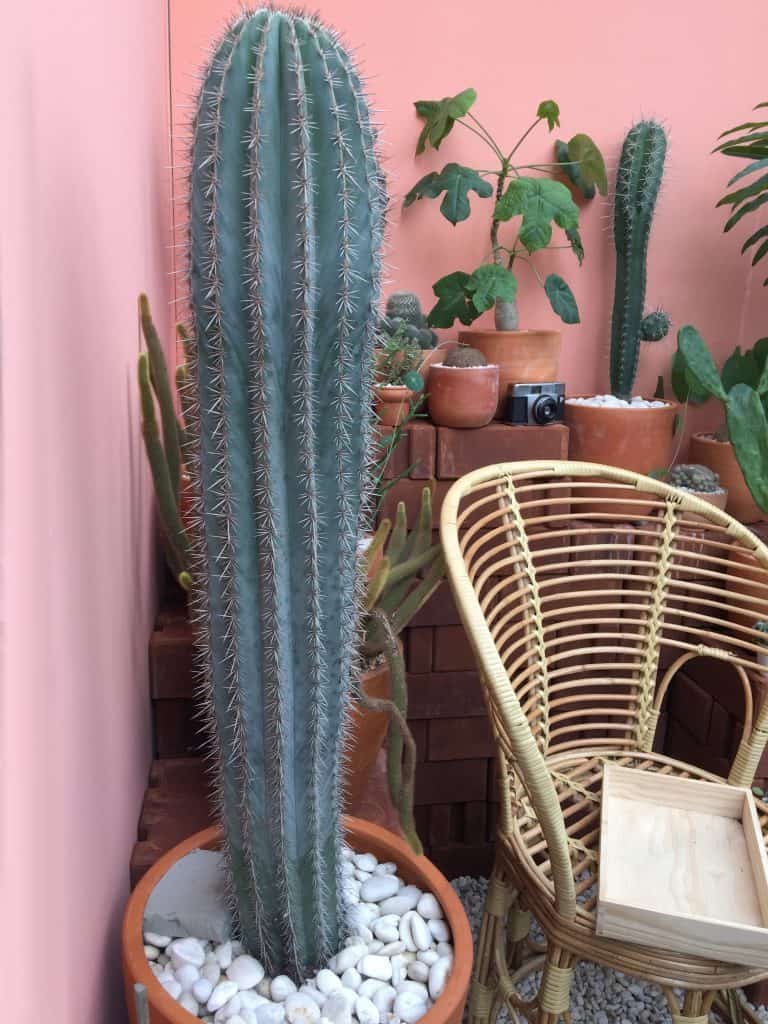The Blue Torch Cactus is a perennial branching columnar cactus that is native to Brazil. This cactus typically has thick skin that is covered in a fine soft fur. Its coloring is a magnificent azure blue with yellow or orange spikes protruding vertically along the defined ribs. The Blue Torch Cactus have white trumpet shaped flowers that blossom during its blooming season in spring and summer. Other common names for this succulent include Blue Candle Cactus, Torch Cactus, and Brazilian Cactus.
Blue Torch Cactus Care
The Blue Torch Cactus is a succulent that is very durable, therefore it is very easy to grow and maintain. This cactus is a great option for beginner gardeners and adds beautiful color to any garden or home.
Light Requirement
Blue Torch Cactus is used to a tropical climate and requires plenty of sunshine. Keeping the Blue Torch in direct sunlight for 8 to 12 hours a day is recommended. This cactus will exhibit more vibrant colors the more sun that it receives; if you notice that the cactus is green rather than blue, that may be a sign that it needs more sun. The Blue Torch can be kept outdoors or indoors. If you opt for keeping it inside make sure to keep it on the sunniest windowsill in your home, preferably a south or west facing window. If kept inside, provide the cactus with at least 4 to 6 hours of sun exposure. If you are moving the Blue Torch from indoors to outdoors, take a couple weeks to acclimate it to full outdoor sun or the cactus may experience sunburn. Allow for a few hours of full sun, then move the cactus to a shaded spot. After about 2 weeks, the cactus should be acclimated and may be left in full sun. If you see yellow discoloration on your Blue Torch, it has been sunburnt, and you should move it back into shaded areas and provide treatment.
Soil Type & pH Requirement
The Blue Torch Cactus functions well in dry climates. Using a well-draining and poor soil blend is ideal for this succulent. You can use a cactus soil blend, adding perlite to help with drainage if necessary. You can also add sand to the soil to create a gritty texture for the cactus. Blue Torch Cacti also favor soil that is neutral or slightly acidic so keeping the pH level between 6.1 and 7.3 is recommended.

Watering Requirement
Like most cacti, the Blue Torch Cactus has minimal watering needs. The cactus soil should dry almost completely between waterings. A good way to check if your cactus needs water is to stick your finger into the soil to see if the first few inches of soil are dry. Wet soil means you can wait to add any water to your plant, while dry soil means it is time for another watering. If your cactus needs water, pour enough water to soak the cactus but make sure that it is draining properly and not becoming waterlogged. It is important not to waterlog or overwater your cactus, as this may lead to root rot in the plant. The Blue Torch will need more water during its growing season in the spring and summer but will go dormant in the winter and therefore requires fewer waterings during this time. If you notice that your Blue Torch has softened skin, a limp body, or yellow discoloration then those are signs that it has been overwatered. On the other hand, if the Blue Torch has dry patches, shriveled skin, and brown discoloration then these are signs of underwatering.
Temperature Requirement
Being native to tropical regions, the Blue Torch Cactus loves hot environments, and their ideal temperature is 70°F to 80°F (21°C to 27°C). However, this hardy cactus can endure temperatures of 100°F (37°C) and up. The Blue Torch will suffer when exposed to frost or freezing temperatures and should not be kept below 30°F (-1°C). If you live somewhere that experiences freezing temperatures at wintertime, it is recommended to bring your Blue Torch inside or cover the cactus with blankets or sheets. The Blue Torch Cactus also prefers humid environments, from 40% to 70% humidity, however it will still grow in arid conditions.
Hardiness Zone
The Blue Torch Cactus is hardy in zones 9b to 11b. These regions have tropical environments and experience mild winters.
Fertilization Requirements
Blue Torch Cactus rarely needs fertilization. It is a fast-growing succulent and does not require high nutrient soil. However, if you do choose to add fertilizer, do so in the Blue Torches growing season during spring and summer. Use a water-soluble diluted fertilizer and fertilize 1 or 2 times during the growing season. The Blue Torch will not need fertilizer while in its dormant state in winter. It is also recommended to add vermicompost or traditional compost to the soil blend every 2 years.
Blue Torch Cactus Propagation
The Blue Torch Cactus can be propagated similarly to other plants, through fresh cuttings from a healthy mature plant. Cut 1 to 2 inches off the top of your mother plant and set aside to allow the cutting to dry out and callous. Once this has occurred, place the cutting into a clean pot with well-draining soil; cover the whole cutting with soil or leave only the healthy part above soil level. Wait 5 to 7 days and then water around the edge of the pot. Wait a couple of weeks, checking moisture levels regularly and adding water if necessary. Once it has had time to root, you can check by gently holding the cactus and lightly pulling on it, checking whether you feel any resistance from plant. If you do feel resistance, this signifies that it has rooted into the soil. Provide this cutting with the same care as an adult Blue Torch.
A Blue Torch Cactus can also be grown from seeds, although it is a lengthy process. To grow the Blue Torch from seeds, use a clean pot filled part way with well-draining soil. Mist the soil and spread the seeds on top; there is no need to keep the seeds evenly spread since Blue Torches germinate well in clusters. Use a plastic wrap or bag with holes in it to cover the pot and keep it in a warm and sunny spot, somewhere 70°F or higher, and mist the pot with water every 2 to 3 weeks. You may see cacti sprouting within a month or within a few months. Once these new cacti are about an inch long, you can move them into their own pots and provide regular care.
Blue Torch Cactus Size and Growth Rate
The Blue Torch Cactus grows quickly, growing tall and upright, and most of its growth occurs in spring and summer. As an indoor plant, this cactus will grow around 10 to 12 feet, however outdoors or in the wild they can grow up to 30 feet. While the Blue Torch does grow quickly, it prefers small spaces and should only be repotted every 2 to 4 years. Use a pot that is the next size up and repot in springtime when it is actively growing.
Common Pests and Diseases
Although the Blue Torch Cactus is a hardy plant, it can experience pest issues or disease.
Some of the common pests that may infest your cactus are mealy bugs and scales. Mealy bugs are tiny bugs covered in a white fuzz that will appear on plants and can be fatal if left untreated. Scales are small insects that feed on different parts of the plant and can cause severe damage to your cactus. If you see these on your Blue Torch, starting treatment immediately is crucial. Move your cactus away from any other plants and keep them isolated for a couple of weeks up to a month. Spray the cactus with a high-pressure water hose to rinse the bugs off or use a soft bristled brush to sweep the bugs from the plant. Use 70% rubbing alcohol as a spray for the plant or on cotton swabs to remove and kill the bugs. You can also use neem oil or insecticidal soap as a spray to treat your cactus as well.
Another issue that may occur while growing your Blue Torch is the common disease root rot. Blue Torch Cacti can easily be overwatered or waterlogged if their soil does not drain well enough. Root rot will develop from these conditions and eat away at the roots on this cactus, killing it if the disease goes untreated. To treat root rot, pull the cactus from its pot, wash off the roots, and cut away any soft, brown, or black roots. Dilute hydrogen peroxide in water and spray the mixture onto the roots. Repot your Blue Torch in a clean pot with well-draining soil and continue to use the hydrogen peroxide mixture on your plant for a few weeks.
Is the Blue Torch Cactus Toxic?
The Blue Torch Cactus is non-toxic to humans and animals.
Where Can You Find the Blue Torch Cactus for Sale?
The Blue Torch Cactus is a rare variety of cactus that can be purchased in specialty shops online as well as on Etsy. The price for this cactus ranges from $10 to upwards of $100 depending upon the size that you are purchasing.
